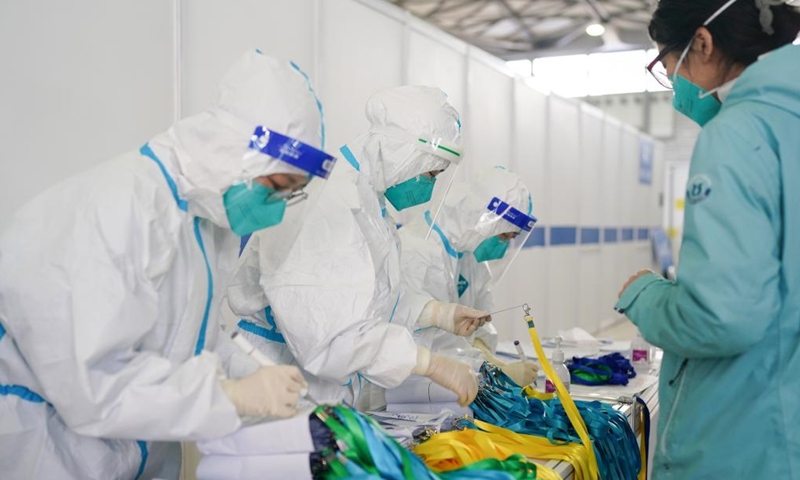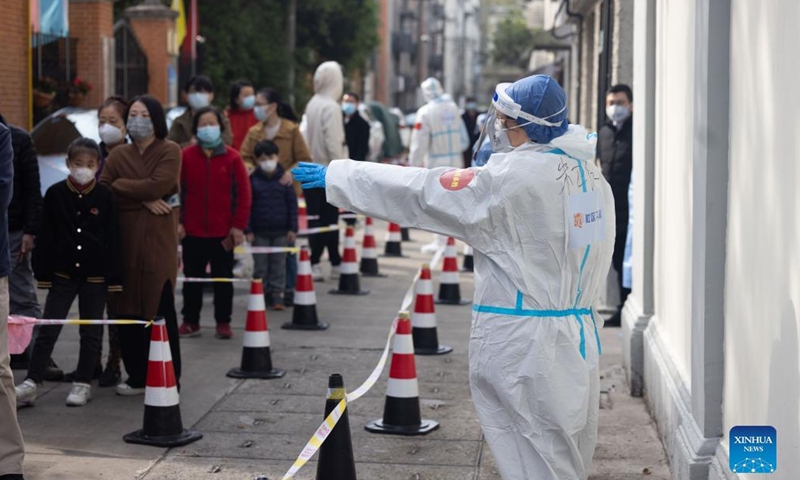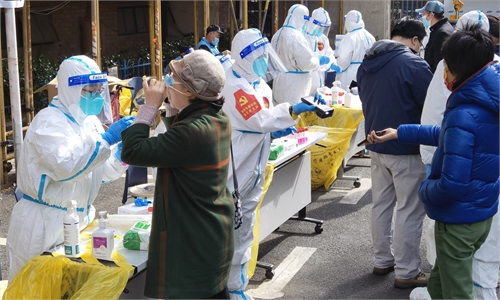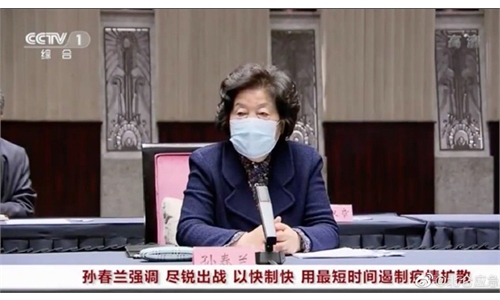China reports record-high five-digit daily infections with Shanghai worst hit, new variant found in Suzhou

Medical workers work in the quarantine zone at the Shanghai New International Expo Center in east China's Shanghai, April 1, 2022.Photo:Xinhua
The Chinese mainland reported 13,146 local COVID-19 cases on Sunday, including 1,455 confirmed and 11,691 asymptomatic ones, the highest number of daily increase since the latest outbreak, which has already infected over 100,000 people.
While one of the severest-hit regions in Northeast China's Jilin Province successfully curbed the epidemic, the infection curve has not seen signs of decline, and a new Omicron variant mutation was detected in East China's Jiangsu Province, neighboring Shanghai, where the mass majority of cases in China have been found in recent days.
Shanghai in particular, reported 438 local confirmed and 7,788 asymptomatic cases on Sunday. Chinese Vice Premier, Sun Chunlan, on Saturday made an official visit to the city to help battle the virus.
Sun stressed that the dynamic zero-COVID strategy must be upheld with resolute and swift action, while recognizing the enormous challenges that the mega city of 25 million faces in both maintaining the normal operation of its core functions and battling the Omicron variant outbreak.
Even with the Omicron variant, as long as we take proactive measures, it still can be brought under control, said Zhang Boli, an academician from the Chinese Academy of Engineering and head of the Tianjin University of Traditional Chinese Medicine (TCM), adding that the high percentage of asymptomatic cases in the current epidemic outbreak is due to the characteristics of the variant itself, but is also tied to the speedy mass testing rollout.
Zhang also noted that the increase in vaccination rates among residents has boosted herd immunity against the virus, and those who get infected will show lighter or no symptoms. As of Sunday, the Chinese mainland had administered a total of over 3.27 billion doses of COVID-19 vaccine, according to health officials.
Wu Zunyou, chief epidemiologist of China's Center for Disease Control and Prevention, said on Friday that the reason that China reports more asymptomatic cases and fewer severe cases is not the result of the characteristics of Omicron, as foreign countries are reporting even more deaths caused by Omicron compared with that of Delta.
"It is the result of our effective epidemic prevention work, namely the early identification of the epidemic, timely response, and the whole-process management for all infected people, including the asymptomatic cases, giving them traditional Chinese medicine to improve their immunity and prevent severe infection," Wu said.
If more asymptomatic cases are to be discovered as the epidemic progresses, there is a possibility that the asymptomatic cases who meet the quarantine conditions can be quarantined at their own homes, Chen Erzhen, the deputy head of Ruijin Hospital in Shanghai, said in an interview with the People's Daily on Friday.
Wu said that epidemic control would be more challenging for a city when infections exceed 10,000 within a short period. For one thing, more patients need to be treated and greater quantities of close contacts need to be quarantined; for another thing, medical staff are put under increased pressure. However, he believed that the Chinese tradition of helping others in need will help regions win this hard battle eventually.

Community workers guide local residents to do nucleic acid test in Changning District of east China's Shanghai, April 1, 2022. Shanghai has launched a nucleic acid testing campaign in areas west of the Huangpu River from Friday amid the second phase of the city's closed-off management.Photo:Xinhua
With Shanghai's hospital system on the verge of being overwhelmed, medical teams and supplies from across the country are flooding in to help fight the outbreak, with thousands of medical workers coming from neighboring provinces of Jiangsu and Zhejiang to assist in nucleic acid testing and the building of makeshift hospitals among other epidemic prevention tasks.
Apart from medical supplies, food and other daily necessities are being sent to Shanghai to ensure local residents maintain a state of normalcy. A total of 10 regions from across China had come to the aid of Shanghai as of Sunday.
Shanghai has distributed antigen self-testing kits to help with citywide screening. The renowned local infectious disease expert Zhang Wenhong said that through the antigen test, authorities can acquire the basic infection data and contain parts of the infection sources so that they can prevent the transmission in a timely manner. To conduct antigen tests aside from the nucleic acid test can also boost the efficiency, he said.
Suzhou in East China's Jiangsu Province, which borders Shanghai, discovered a confirmed coronavirus disease patient infected with a mutation VOC/Omicron variant BA.1.1, unidentified in previously found strains worldwide, posing new threats to the already dangerous situation in the region.
Another hard-hit region by the epidemic, Jilin Province, has seen little sign of improvement, recording 4,455 cases on Sunday. Jilin city announced on Sunday that it had successfully curbed the virus.
Global Times


